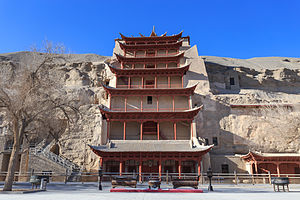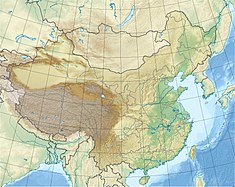| Mogao Caves | |
|---|---|
| Native name 莫高窟 (Chinese) | |
 Cave 96 of the Mogao Caves | |
| Location | Dunhuang, Gansu, China |
| Coordinates | 40°02′14″N 94°48′15″E / 40.03722°N 94.80417°E |
| Type | Cultural |
| Criteria | i, ii, iii, iv, v, vi |
| Designated | 1987 (11th session) |
| Reference no. | 440 |
| Region | Asia-Pacific |
| Mogao Caves | |||||||||||||||||||||
|---|---|---|---|---|---|---|---|---|---|---|---|---|---|---|---|---|---|---|---|---|---|
"Mogao Caves" in Chinese characters | |||||||||||||||||||||
| Chinese | 莫高窟 | ||||||||||||||||||||
| |||||||||||||||||||||
The Mogao Caves, also known as the Thousand Buddha Grottoes or Caves of the Thousand Buddhas, form a system of 500 temples[1] 25 km (16 mi) southeast of the center of Dunhuang, an oasis located at a religious and cultural crossroads on the Silk Road, in Gansu province, China. The caves may also be known as the Dunhuang Caves; however, this term is also used as a collective term to include other Buddhist cave sites in and around the Dunhuang area, such as the Western Thousand Buddha Caves, Eastern Thousand Buddha Caves, Yulin Caves, and Five Temple Caves. The caves contain some of the finest examples of Buddhist art spanning a period of 1,000 years.[2]
The first caves were dug out in 366 CE as places of Buddhist meditation and worship; later the caves became a place of pilgrimage, and caves continued to be built at the site until the 14th century.[2][3] The Mogao Caves are the best known of the Chinese Buddhist grottoes and, along with Longmen Grottoes and Yungang Grottoes, are one of the three famous ancient Buddhist sculptural sites of China.
An important cache of documents was discovered in 1900 in the so-called "Library Cave", which had been walled-up in the 11th century. The contents of the library were subsequently dispersed around the world, and the largest collections are now found in Beijing, London, Paris and Berlin, and the International Dunhuang Project exists to coordinate and collect scholarly work on the Dunhuang manuscripts and other material. The caves themselves are now a popular tourist destination, but the number of visitors has been capped to help with the preservation of the caves.[4]
- ^ Murray, Stuart A. P. (2009). The Library: An Illustrated History. Chicago: Skyhorse Publishing. p. 49. ISBN 978-1-61608-453-0.
- ^ a b "Mogao Caves". UNESCO. Retrieved 2007-08-05.
- ^ Zhang Wenbin
- ^ Makinen, Julie (27 September 2014). "Getty Institute helps save China's Mogao Grottoes from tourism's impact". Los Angeles Times.

